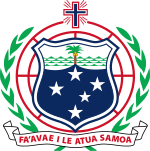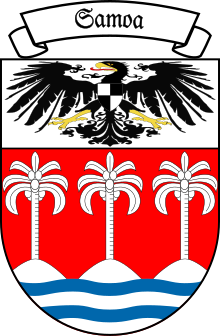Samoa coat of arms
| Samoa coat of arms | |
|---|---|

|
|
| Details | |
| Introduced | 1962 |
| Heraldic shield | southern Cross |
| Previous versions |
|
The coat of arms of Samoa was adopted in its current form with independence in 1962.
description
The shield shows the silver constellation Cross of the South in dark blue , in the head of the shield there is a naturally depicted coconut palm with golden nuts on a silver background in front of green-white sea waves and a silver sky.
The shield has a dark blue and white border. It rests on two red, concentric circles connected by radial lines, around which two green olive branches are entwined.
Above the shield is a dark blue, red and white bordered Latin cross with red rays.
Below is a white banner bearing the state motto in Samoan :
- " FA'AVAE I LE ATUA SAMOA. "
- " God be the foundation of Samoa "
symbolism
The Southern Cross is the coat of arms and flag symbol of numerous areas in the southern hemisphere and was adopted here from the Samoan flag .
Coconut palm and sea indicate the natural location of the islands in the Pacific. The cross represents the country's Christian tradition.
The circles and lines represent latitude and longitude coordinates and date as the olive branches from the flag of the United Nations , the Samoa from 1946 until independence as a Trust Territory of New Zealand manage left. They were also present in the coat of arms introduced in 1951.
history
The coat of arms developed from older symbols. A first coat of arms was introduced by the German colonial power in 1914. It showed three silver palm trees in red over blue and white wavy lines, in the head of the shield, as in the coats of arms of all German colonies, the black Prussian eagle in silver.
This coat of arms was only in use for a very short time, as New Zealand troops conquered Samoa a few months after its introduction. Under the New Zealand League of Nations mandate , a plaque was introduced in 1920 that also showed three palm trees - in natural colors.
In 1951 the forerunner of today's coat of arms was introduced, which sometimes showed different colors and a rising golden sun above the shield instead of the cross. This half sun was then replaced by the cross.
literature
- Karl-Heinz Hesmer: Flags and coats of arms of the world. History and symbolism of the flags and coats of arms of all states . Gütersloh: Bertelsmann Lexikon Verlag, 1992. ISBN 3-570-01082-1
Web links
- Entry on www.ngw.nl (English)
- Portrait of the coat of arms on the pages of the Samoan government


